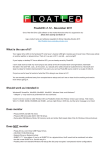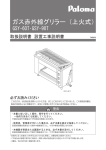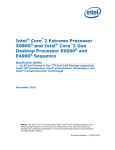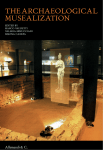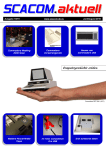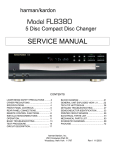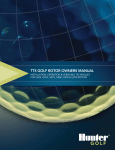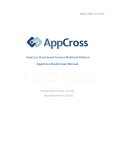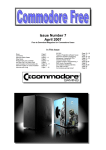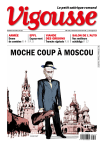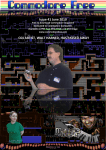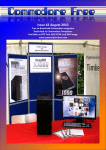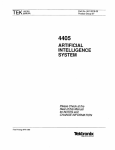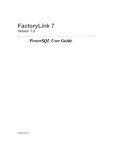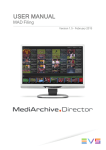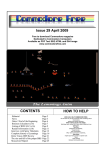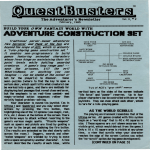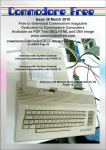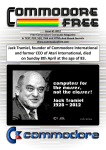Download Commodore Free issue 46
Transcript
Issue 46 November 2010 Free to download Commodore magazine Dedicated to Commodore Computers Available as PDF Text SEQ HTML and D64 image www.commodorefree.com Commodore Free Magazine CONTENTS www.commodorefree.com Editorial Page 3 NEWS Coming New C64 release:1,000 KUNG-FU MANIACS! Amiga Monthly Page 16 for Reading Not Just Another D64 Viewer (NJAD64V) V1.1 HyperViper for the Commodore 64 almost ready PAGE 4 NEWS Joyport switcher The Richard Joseph Tribute PAGE 7 NEWS COMMODORE 64 TAPE MASTERING PROGRAM Kickstart ROM Replacement(Phase I) Bounty Assigned More videos from CommVEx v6 2010 PAGE 8 NEWS PAGE 9 THE FULL VERSION OF HOSTILE BREED FOR THE AMIGA HAS BEEN PRESERVED AND RELEASED BLITTERWOLF MONTHLY PAGES Chuck Norris [2010] 5ALAD "Low res. Graphics" NEWS C64 TRUETYPE V1.0/STYLE OPTIONS PAGE 10 NEWS Commodore PET SYNTH IBATCH 1.0 BATCHPROCESSING FOR IMAGES PAGE 11 NEWS WINUAE 2.3.0 RELEASED PAGE 12 The TPUG Library CD PAGE 13 INTERVIEW WITH Joan Malé, CREATOR OF 5alad "low res. Graphics PAGE 15 COMMODORE FREE REVIEW OF NOT JUST ANOTHER d64 viewer PAGE 21 MCC-216 review BY Commodore Free Magazine PAGE 24 MCC QUICK LOOKS BY COMMODORE FREE PAGE 30 Back to the Past, issue 7, April 2007 By Neil Reive PAGE 33 Page 2 Commodore Free Magazine www.commodorefree.com EDITORIAL Hi GFX Fancy some Snazzy Commodore 8-bit graphics Synchronised to Midi instruments, jumping around and flashing colours on screen. Well this issue we have an interview with such a creator, namely Joan Malé, he is the creator of the Commodore 5alad project. This project is a Synchronised Commodore Computers with 8 bit graphics with connected to midi instruments. I have been contacted by a number of people asking about advertising in Commodore Free, if your group/club would like to advertise. Please again feel free to contact me; I don’t charge for advertising, of course any free samples would help me ensure the pages are listed for longer (ahem yes well we wont go into that). REVIEWS My comments and reviews are sometimes harsh and I have received many comments about them, thanks! I review products mcc This issue Commodore Free look at the mcc-216 Multi Machine as I see them as honestly and fairly as I can; and no amount of bribes will sway me! If a product is good, I will say so I also like Computer; this is an emulator the hardware is all FPGA logic, to point out any problems I have had with devices. I know allowing the loading of “cores” these contain the virtual machines, and currently the device is supporting the Commodore some commercial magazines seem obliged to give good reviews because the product is advertised, without advertising 64; but with constant development underway for the Amiga (the system can already load and play most Amiga Demos) and revenue the magazine would have to close. Because CommoAtari 2600 as well as other 8 bit systems. The review was con- dore Free doesn’t have any financial commitments, then I review as I see the products, as fully as I can. Of course this is ducted by Commodore Free well ok it was ME (Editor) who it from a personal perspective if you feel differently about a reseems was the first U.k. Customer of the device; we (erm I) agreed to hold back reviews until small teething problems had view write in and I will share your comments, what seems good to me may seem awful to someone else and visa versa been ironed out in the system. The device is a work in progress, and is very actively developed. As this issue goes to press Well thanks goodness I have run out of Editorial space lets (well download) the developers are already implementing some of my suggestions and observations. I would like to thank start the magazine the team for there patience with me, and the fact they very quickly answered some of my questions and concerns. The de- If you have any reviews, comments, suggestions or tutorials you would like included feel free to contact me, you will find vice may not look cool, but it works impressively well. the address on the website NEWS Best regards We continue Commodore Free with a look at the latest news Nigel (Editor) from around the world, where would we be without all those Commodore Free ground breaking developments. I would like to thank people who pointed me to stories for inclusion in Commodore Free. If you have any news items then please feel free to contact me; I am especially interested if you are the developer of any sort of hardware or software device for Commodore computers, of course other platforms may be covered if I feel the news item is worthy for our Commodore Readers. ADVERTS Complete Computer Fireworks Celebration Kit, Page 3 Commodore Free Magazine www.commodorefree.com NEWS Coming New C64 release: 1,000 KUNG-FU MANIACS! Alf Yngve, Richard Bayliss and Jon Wells have been working on an entirely new game, titled 1,000 KUNG-FU MANIACS! This side-scrolling beat-em-up is also a parody game, featuring loads of gags, send-ups and humorous twists. A YouTube video of the game, with more information and backstory, can be found here: http://www.youtube.com/watch?v=turnE_figC0 Next Issue Commodore Free have a review with Alf Yngve Amiga Monthly Page 16 for Reading SHORT RUN DOWN OF MONTHLY PAGE ISSUE SIXTEEN : - Interview with Insane-Software (2 pages) (Article by Gebrochen) - AmigaOne X1000 - Finding Nemo (Article by Hypex) - Some advert pictures. - Top ten downloads OS4depot. Not Just Another D64 Viewer (NJAD64V) V1.1 Hi Commodore Free Readers! I am all done with my recent 1 year update for the SOAMC= Amiga recordings. I'm still enjoying your great magazine with great respect. You may remember me from the SOASC= interview, www.65818580.com. I have updated my D64 viewer software today and thought it should be something for the readers to know about. I think there are a good wealth of D64 viewers and exporters of .PRG files and such out there already, but I never came across software that focuses on printing, text files and real graphics (for inclusion into websites for instance) including the neat feature of printing labels for those good ol' floppy disks. direct link here : http://www.blitterwolf.com/monthly.html Not Just Another D64 Viewer (NJAD64V) V1.1 A tool that will display the contents of D64 disks as real Commodore 64 graphics using the original chars and colours without having to use any emulator or a real C64. From that point you are able to graphically or textually export the information stored in the directory structure of the D64 disks. Outputs are: PNG, TXT, CSV and PDF (purpose of label printing) Regards from Stein Eikesdal also known as www.stone-oakvalley-studios.com http://www.stone-oakvalley-studios.com/index_software.php http://www.stone-oakvalleystudios.com/software/screenshots/njad64v.png HyperViper for the Commodore 64 almost ready Available soon from Psytronik Software: http://www.psytronik.net A new game is coming soon - after 22 years - HYPERVIPER is coming to the C64/128 - recoded in 6502 assembly by Jamie Howard The C64 version will feature: * improved graphics and sound over the MSX original * fully licensed cover version of AM180 by Grandaddy for main theme * extra life bonus feature See a demo here: http://youtube.com/watch?v=qo91kc9Nxz0 Page 4 Commodore Free Magazine Joyport switcher www.commodorefree.com NEWS Please let me know if you would be interested in me getting some of these produced for sale. Thought I'd start a new thread on my Joy port switcher now that I have the final PCB done. This was the original thread: http://www.lemon64.com/forum/viewtopic.php?t=35124 (text is copied Below) Below is a picture of the finished product. A quick operational run down: I'm just gathering interest to see if I should go ahead and get some PCB's made for yet another joystick switcher option. I know there is currently another new design being done, but there's nothing wrong with options. Port 1 to Port 1 Port 2 to Port 2 Or Port 1 to Port 2 Port 2 to Port 1 This design is more suited towards people like me, who are the only person playing my C64, I don't need two joystick inputs for two player games, but I sure get sick of swapping the one joystick I have over for every game I play. If you ever wanted to play a two player game just unplug it! The grey push button toggles the inputs to switch like so: It switches the digital signals from the joystick and the analogue signals for the mouse or paddles. The Green LED is turned on when the ports are being swapped. It remembers the last swap state when turned off and will resume that mode when the C64 is next turned on. Provides ESD protection for the C64's CIA's as there is no direct connection from the C64's ports to the joystick inputs. So, I have completed one in prototype stage and it works good. I might make it available as a DIY kit if there is enough interest for a DIY kit, but certainly as a fully assembled & testSorry but I don't have a final price yet, I've got enough parts ed unit. With a target price of $20 - $25 USD plus shipping, it to make 20 to see how things go. should work for C64, Vic20 and C128, I just need to confirm the joystick port spacing due to the way I've decided to mount I hope to have some ready for sale in a few weeks. Things are the joystick port connectors. just a bit hectic at work right now I haven't really got time to I have taken a different approach to my design by using an At- make a bunch of them up. mel AVR Mega8 processor, which in the scheme of things is Thanks, Ross total overkill, but, they only cost $3 ea, probably cheaper in parts costs than a logic type design. Operation is like so, there is a push button on the PCB that toggles between switching the Joystick input to Port 1 or Port 2 on the C64, on the final design there will be two LED's next to the Ports to indicate which one is active. So the cool part is this design will remember the switch state, even when the power is off, this saves you having to switch ports each time you play the same game between power ups. So if you had Port 2 selected, next time you turn the C64 on, Port 2 will automatically be selected. The picture gives an indication on the final parts layout, this is not a real PCB, but it gives you some idea on what to expect. The Richard Joseph Tribute After 3 long years of waiting... Onslaught, Samar and Protovision present to you a carefully constructed musical tribute to one of the Commodore 64’s pioneering musicians who sadly passed away back in 2007. The collection contains over 20 SID remakes from a wide selection of active musicians, covering some of the memorable C64 and other platform game music Richard Joseph composed during his career. This production was released at X’2010 demo party on the 3rd October. Available for download at CSDb: http://noname.c64.org/csdb/release/?id=94536 Page 7 Commodore Free Magazine www.commodorefree.com NEWS PRG (READNUM.PRG), in case you'd like to try mastering them as a kind of tutorial to mastering tapes with Nova Master. COMMODORE 64 TAPE MASTERING PROGRAM About the program Nova Master A1000SA is a tool which allows you to master your C64 games, utilities or other applications with the classic Novaload loader. http://noname.c64.org/csdb/getinternalfile.php/92460/Nova Master.zip http://noname.c64.org/csdb/release/?id=94751&show=notes Currently, Nova Master will only convert your programs to the A1000SA version which does not support loading pictures. Hence the "A1000SA" in the title. Other versions might get implemented in the future. My aim when writing Nova Master was that the user can master his program as easily and effortlessly as possible. A lot of things will be done automatically for you, when you master your programs with Nova Master. Also included with Nova Master is Read Num 64, which has been mastered with the program. I have also included the filename and loader TAPs (READ1.TAP & READ2.TAP) and the Kickstart ROM Replacement (Phase I) Bounty Assigned Description: 1. Bring The m68k compile of AROS back out of unmaintained. The Kickstart ROM Replacement (Phase I) bounty has been assigned to Jason McMullan. The bounty aims at enabling AROS to build for m68k Amiga system. This part does not include binary compatibility with existing m68k Amiga applications. The deadline for this work is 31st December 2010. Jason has been working behind the scenes for some time and now he has started adding compatibility changes directly to AROS source code tree. For the time being he built the kernel and now is working on getting OCS driver implemented. 2. Must initially work from whatever means is possible so long as the build is going again, and the codebase is brought up to date with the changes in the x86 native/hosted flavours. (i.e. you could use some command in AmigaOS to bootstrap aros or similar) 3. Initially binary compatibility isn’t needed with AmigaOS (not until at least you can get the thing working again) 4. Must compile the main components of AROS (read AROS main cvs branch), and optionally allow other components to compile. The bounty details and donate page can be found here http://www.power2people.org/projects/profile/5 5. Proof of bounty. More videos from CommVEx v6 2010 > http://blip.tv/file/4042940 -----Original Message----From: Robert Bernardo To: commodorefree Subject: More videos from CommVEx v6 2010 > the 1541 Ultimate v2 by Josh Shiflet > http://blip.tv/file/4083741 I wrote: > The latest on Amiga Computers by Lars Nelson > http://blip.tv/file/4084042 > CommodoreServer.com, V-1541, Comet64 Internet Modem by Greg Alekel > http://blip.tv/file/4038591 Another couple of CommVEx v6 videos have been released. They are > Portland Commodore User Group - PDXCUG by Greg Alekel > http://blip.tv/file/4042778 Commodore 64, VIC-20, and Ham Radio by Roger Van Pelt http://blip.tv/file/4219138 > Enhanced Music Player for the iPad by Keith Henrickson > http://blip.tv/file/4042847 Amiga Forever and C64 Forever by Michael Battilana http://blip.tv/file/4219211 Now being released in MPEG-4, Robert Bernardo Fresno Commodore User Group http://videocam.net.au/fcug > Commodore Programming Resources by Larry Anderson > http://blip.tv/file/4042913 > Disabling the NMI by Steve Davison Page 8 Commodore Free Magazine www.commodorefree.com NEWS THE FULL VERSION OF HOSTILE BREED FOR THE AMIGA HAS BEEN PRESERVED AND RELEASED The full version of long lost Palace Software game Hostile Breed has been located and released by Amiga Games That Weren't: http://agtw.abime.net/games/view/hostilebreed Hostile Breed was widely reviewed in the various Amiga magazines but disappeared when Palace went under. aGTW features the full three disk game in ADF and IPF format as well as interviews with artist Joe Walker and programmer Rob Stevens. A manual has been created for the game so please report any errors or suggest addenda. BLITTERWOLF MONTHLY PAGES www.blitterwolf.com another Amiga PDF issue SHORT RUN DOWN OF MONTHLY PAGE ISSUE FIFTEEN : - Interview with DiscreetFX (Article by Gebrochen) - Getting to Grips with Hollywood (Article by MickNish) - Some advert pictures. - Top ten downloads OS4depot. Download the pages from Here http://www.blitterwolf.com/monthly.html Chuck Norris [2010] Commodore free Don’t know much about this bet this is a Interesting animation demo and available from here http://noname.c64.org/csdb/getinternalfile.php/91993/chu ck norris .prg It uses ASCII art to show a person walking past the sun, the thing that struck me was how fluid the animation is see what you think Joan Malé Programmed his own synths to be used from laptops at that time. Not happy with all of this work, he programmed his own visuals, released in a separate DVD, to be 5alad is the parallel project created by Joan Malé (more played in live in real machines and synchronized with actual known as Monoceros) using "obsolete" hardware, that has been developing at the same time as the "eBay" orchestra has software. Its been hard work that has taken about 1 and a half years to complete. been growing. A project that started in a tender age of be"Low res. graphics" is a step away from the chiptune, between 1982-83 with a Commodore 64 and a Casio vl-tone. tween "Beverley hills cop", "Miami Vice", Kraftwerk, Super Closing the circle (or nearly), some years after, culminated Mario, OMD and of course today´s electro and IDM. with this work where some old computers and synths that have been used, like the Commodore 64, the plus/4, Casio cz101, Roland CR5000, Yamaha CX5M (more info at the credits) CD include 13 tracks + 3 archives ready to load in .WAV format for the laptops, NEC Pc 8201, Tandy model 100, Canon and some of today´s plugins, using speech synths that was used by Kraftwerk at the time, and rhythm and synth soft de- X-07 veloped in the 80´s that was used in platforms like ZX specRELEASE DATE: FEB-15-2010 trum, MSX etc.. http://www.inrecs.com/releases.php?id=42 5ALAD "Low res. graphics" Page 9 Commodore Free Magazine www.commodorefree.com NEWS C64 TRUETYPE V1.0/STYLE OPTIONS The first version of our effort at a complete and proper TrueType font (TTF) representation of the legendary C64 character set. The package provides five (5) TrueType formatted fonts addressing different needs. Highlights: - accurate, efficient, technically valid, multi-functional, and user- friendly. - traditional monospace representation. - variable width but pixel accurate representation. - mapped to ASCII with additional Unicode page & CP-1252 mappings where relevant. - "C64 Elite Mono" provides simple mappings directly to character ROM indices and the four PETSCII 'modes'. - .eot (Embedded OpenType) and .woff (Web Open Font Format) files ready to use on your own website. See http://style64.org/c64-truetype to download, to get more information including mapping tables and our rationale for producing a new TrueType package, or to report bugs/suggestions. -expansive set of mappings from printable ASCII, CP-1252, and relevant Unicode pages to C64 glyphs - superset of "C64 User". -includes all 304 unique C64 glyphs in monospace form mapped from character ROM indices (PUA base U+EExx) to allow mixing variable and fixed width glyphs. C64 Pro Mono -monospaced outlines... -expansive set of mappings from printable ASCII, CP-1252, and relevant Unicode pages to C64 glyphs - superset of "C64 User Mono". -includes all 304 unique C64 glyphs mapped from character ROM indices (PUA base U+EExx). C64 Elite Mono -monospaced outlines... -direct simple mappings from character ROM indices (PUA base U+EExx) and PETSCII upper+graphics, lower+upper, reverse upper+graphics, and reverse lower+upper modes (PUA base U+E0xx). Package contents: C64 User -variable width outlines suitable for modern text layout in your favourite word processor and desktop publisher or for embedded display on a website. -minimal set of mappings from printable ASCII to C64 glyphs. -includes extra ASCII glyphs in C64 style to complete ASCII mapping (U+005c, U+005e, U+0060, U+007b, U+007d, U+007e). C64 User Mono -monospaced outlines suitable for retro coding in your favourite programmer's editor or embedded display on a website. -minimal set of mappings from printable ASCII to C64 glyphs. -includes extra ASCII glyphs as above. C64 Pro -variable width outlines... The Commodore Computer Club U.k. www.commodorecomputerclub.co.uk The Commodore Computer Club U.k. www.commodorecomputerclub.co.uk The Uk Commodore club for all Commodore machines Friendly forum http://commodorecomputerclub.co.uk/forums/ The Uk Commodore club for all Commodore machines Friendly forum http://commodorecomputerclub.co.uk/forums/ And Regular Meetings around the U.k. And Regular Meetings around the U.k. Page 10 Commodore Free Magazine www.commodorefree.com NEWS Commodore PET SYNTH PetSynth, the first GPL playable synthesizer for the Commodore PET computer has been released. PetSynth is a program that turns your PET 4032 into a musical instrument with the "finest in 1-bit quality sound". PetSynth performs its magic on a stock PET 4032 computer, for more information on PetSynth and to download the program, go to http://petsynth.org For more information on PetSynth's developer, go to http://www.chironbramberger.com PetSynth Hello and welcome! This is the official project page for PetSynth - the only program for rocking the Commodore PET that the cool kids use. Update: I've added an audio file in .FLAC format that you can download and record to a tape file and use on a real PET. See the guide for details. I've been sitting on this for a year, and I decided that it was finally time to unleash this puppy upon the world! It features a two-octave keyboard layout, selectable note length, many selectable octaves, selectable pulsewidth, vibrato, distortion, and noise or "drum mode" depending on how you use it. All this without adding or hacking the Commodore PET in any way. Plus, it's compiling from C, so it's FAST - with very low latency. This computer does not use a SID 6581 music chip at all! This program was designed, tested, and refined on a real life fully working stock Commodore PET 4032 computer, and the sound is heard coming out of the built-in piezoelectric speaker on the PET 4032 . It does not involve hacking the computer in any way, or adding any extra sound cards. It does not involve taking sound from the tape port. It also does not implement a DAC to create sounds. It's also GNU GPL v2 open source software - so if you like it, you can go hack it yourself. Or pay someone to make it the way you want it. Like me ;) There's nothing that sounds quite like it. It's got a huge sound, and no noise. Really, when I plug it into my mixer, there's no noise at all! I can hardly find any no matter how high I turn it up! The drum sounds are also crazy weird. You can also set the vibrato so high it sounds more like a laser gun or alien telephone. All this from the finest in 1-bit sound on the Commodore PET. I hope you have as much fun playing it as I do! Thanks, -Chiron IBATCH 1.0 BATCHPROCESSING FOR IMAGES iBatch 1.0 (Image Batcher) allows users to easily convert/rename/renumber/resize/rotate a bunch of pictures at once. The pictures to be processed can be collected in a "Batchlist". In order to organize your batchlist iBatch provides a "Viewer" and "Batchlist browser" tool. A fast workflow is guaranteed even on slow systems. This is accomplished by using pre-processed thumbnails/preview images for the "Viewer" or "Batchlist browser" tool. All thumbnails will be kept in sync with their corresponding source directory. Before you start the "Viewer" tool, iBatch will therefore check for existent thumbnails and add missing thumbnails from the given sourcedir. The whole program can be perfectly used for organizing/resizing digicam pics. Furthermore it becomes handy, when you have to convert whole image directories at once. Old ARexx Version (iBatch4b_ger.lha, iBatch4b_eng.lha, iBatch_eng.lha ord iBatch_ger.lha) becomes obsolete. iBatch 1.0 was rewritten from scratch, here are the main advantages/changes: - integrated thumbnail viewer + batchlist browser (no external thumbnail viewer needed any more) - redesigned GUI, very fast and easy to use - integrated GUI for preferences - it is not an ARexx Script any more - c:ImageConverter is not required any more - it is not an AWNPipe base GUI any more. A Stormwizard GUI was chosen instead. - considered to be more "robust" - progress bar - same executable runs on OS 3 up to OS 4.x - support for locale.library - Preferences File - runs on small screen resolutions as well Requirements 24Bit pic datatypes, zlib.library, jpeg.library, wizard.library, lots of RAM (at least for digicam pics) and OS3.x. or OS4.x Runs perfectly on my SAM440. Lots of RAM recommended. For more information and a download head to www.geobiz.de/ibatch.html iBatch will also appear on Aminet soon... Page 11 Commodore Free Magazine www.commodorefree.com NEWS WINUAE 2.3.0 RELEASED New features: - CDTV and CD32 subchannel hardware emulation, CD+G audio CDs supported. - CDTV statefile support. - FLAC compressed CD audio tracks supported (cue+flac or cue+iso+flac). - Automatic centre, max fullscreen and tv-like fullscreen options added. - uaescsi.device SCSI emulation, including full CD audio support. - Pause uaescsi.device CD audio when emulation is paused or GUI is open. - Support for configuration file delayed CD image insert, for example CD32 games F17 Challenge and Last Ninja crash if booted before CD32 boot screen appears... - Right and bottom border, if outside of display area, is blanked instead of filling with current border colour. - Full "Portable"/USB key mode (-portable command line parameter) and relative path support. - Borderless/minimal/normal windowed mode option. Updates: - CD/CD image handling rewrite: * .ccd/.img/.sub and .mds/.mdf v1 image files supported. * Subchannel support (CDTV/CD32 CD+G). * Audio tracks fully supported. * SCSI emulation, CD images and non-SPTI mode full uaescsi.device CD audio support, most common CD SCSI commands emulated. SCSI emulation enabled by default. * Near-instant compressed (mp3/flac) CD audio and zipped CD image startup time. * More reliable CD/CD image and CD image/real drive on the fly change support. - CD32/CDTV more accurate CD audio and animation streaming. - Rawinput keyboard handling improved. - Cycle exact audio and disk DMA sequencer, Paula DMA request line timing fully emulated, (previously DMA accesses were "immediate", all other timing was already exact) - Direct3D bezel overlays and "old" overlays separated, bezel overlays are in overlays-directory, old overlays should be renamed as masks. - Direct3D bezel automatic display area detection and aspect ratio correction. - Disk images inside archives are automatically "extracted" to Disk Swapper and floppy drive paths when dragged and dropped. - 68000 and 68020 cycle exact CPU timing updates. - 68040 MMU emulation compatibility improved, Linux and NetBSD confirmed working. - Keyboard led handling improved. - Rawinput GUI F12 key ignored window focus. - Gameports panel joystick/mouse type (mouse,joystick,analog joystick,..) was ignored when configuration file was loaded. Other bugs fixed: - Direct3D 2x+ shader filter bad image quality. - CDTV CD timecode (Built-in CD player time counter). - CD32 CD end of play notification only worked if play was last sent CD command. (Fightin Spirit) - CD32 CD audio status reporting when attempting to play data tracks (Mission Impossible 2025) - CD32 pad 2-button mode fixes (F17 Challenge, Quik The Thunder Rabbit, ATR) - Audio length detection error if MP3 audio tracks had checksummed frames. - Built-in image mounter CD audio timecode offset fixed. - Z3/RTG RAM leak when restarting. - Direct3D scanlines can be (finally) enabled on the fly. - Configuration file cdimage0=:\ at startup didn't work. - Dynamic hardfiles didn't work reliably with DirectSCSI filesystems. - Dynamic hardfile data corruption if physical file size grew over 4G. - Some demos had blank display (broke in 2.0 Denise updates). - Transparent clipboard support crash fixes. - Initial ROM scan didn't detect Amiga Forever ROM keys correctly. - Joystick axis bogus autofire in some situations when remapping joysticks. - Rawinput was not enabled if only one (physical or logical) keyboard was detected. - RTG mouse cursor problem in D3D mode with enabled filter. - RTG 8-bit fullscreen mode colour error in some situations. - Miscellaneous custom chipset and disk emulation tweaks. - RTS and RTD odd address check was missing, fixes also mysterious JIT crashes. - Epson printer emulation multiple page printing fixes. - plugin directory detection problems. - Rar archive crash. - ~1.5G Z3 Fast RAM works again (64-bit host OS only) and more.. You can download it here: http://www.winuae.net/files/WinUAE2300.zip 2.2 bugs fixed: - Triple/double/single buffer option was not saved to configuration file. - Autovsync didn't work. Page 12 The TPUG Library CD This CD contains thousands of disk images with over 10,000 programs that have benefitted TPUG members for years. Many of these programs are previously released freeware or shareware programs, and many were exclusive to the user community represented by the Toronto PET Users Group. The Commodore PET Series These are the TPUG library disks that run on Commodore PET computers (2001, 4016, 4032, 8032, 8096, Superpet, etc). This folder represents all the PET related disk images. PET disks are separated into sub-folders as follows: The Toronto PET Users Group is a non-profit organization that exists to promote and support users of Commodore equipment. The club was founded in 1979 and over the years compiled a large library of programs for virtually all of the computers that Commodore manufactured. The advent of disk imaging technology has now allowed TPUG to preserve the disk images of the entire library. This is the most complete and comprehensive compilation of the library that has ever been put together, and is the culmination of a two year project to collect, research, organize and image the TPUG library. We tried as much as possible to only image disks that showed no surface blemishes and stuck to the master disks as much as possible. There was simply no way to test all the programs that are on this library CD to ensure that they work properly. However, if you notice any programs that do not run properly or suspect a program may be corrupted, please contact TPUG and we will try to find a working copy for future releases of this CD. In putting together this library CD compilation, it became apparent that several disks were missing from the TPUG library. A search for these disks on the internet and with current and previous members of TPUG, and others, was only partially successful. It would be appreciated if anyone reading this who is in possession of any missing disks and willing to donate copies to TPUG, would contact TPUG at '[email protected]'. A listing of the missing disks appears in text form on the CD THE DISK LIBRARY OF THE TORONTO PET USERS GROUP: Amiga These are the TPUG library disks that run on the Amiga 500, 600, 1000, 1200, 2000, 2500, 3000 & 4000 series of computers. The Amiga library disks are prefixed with the letter 'A', e.g. (A)C1 The Amiga Vision library disks are prefixed with the letters 'AV', e.g. (AV)AAA Total count: 168 (127 library, 30 Amicus, 11 FAUG) Commodore 64 These are the TPUG library disks that run on the Commodore 64 computer or the Commodore 128 in C64 mode. These library disks are prefixed with the letter 'C', e.g. (c)aa Total count: 294 Commodore 128 These are the TPUG library disks that run on the Commodore 128 computer. These library disks are prefixed with the letter 'Y', e.g. (y)aa Total count: 74 COMAL These are the TPUG library disks that run COMAL on the Commodore 64, Commodore 128 and PET series computers. These library disks are prefixed with the letter 'K', e.g. (k)aaa Total count: 83 (plus boot disks) Note: You must first boot up COMAL on these computers in order to use these disks. Several versions of the COMAL boot disks are contained in the root of the COMAL folder (look for 'cboot' or 'kboot'). CP/M These are the TPUG library disks that run on the Commodore 128 in CP/M mode. These library disks are prefixed with the letter 'Z', e.g. (z)aa Total count: 86 (plus boot disks) Note: You must first boot up CP/M on the Commodore 128 in order to use these disks. Several versions of the CP/M boot disks are contained in the root of the CP/M folder (look for 'cpmboot'). CRS These are the TPUG library disks that run on the Commodore 64 & Commodore 128 computers. These library disks are prefixed with the letters 'CRS' with the sequence number, e.g. CRS01. Total count: 70 These are disks made up from the archives of Canada Remote Systems, a bulletin board system active in the 1980's that was located in Mississauga, Ontario, Canada. The CRS bulletin board offered programs and utilities for many 8-bit platforms, and the disks included here are the ones specifically for Commodore systems. These were originally to be included in the TPUG library after CRS became defunct. GEOS These are the TPUG library disks that run on the Commodore 64 computer in GEOS mode. These library disks are prefixed with the letter 'G', e.g. (g)a1 Total count: 57 You must first boot up GEOS on the Commodore 64 in order to use these disks. MS-DOS These are the TPUG library disks that run on MS-DOS based Commodore computers, PC10, PC20, PC30, PC40. These library disks are prefixed with the letter 'M', e.g. (m)aaa Total count: 25 (plus additional disks) These have the individual PC files for each disk located in each of the folders NEW SUBMISSIONS These TPUG library disks run on the various Commodore computers. These library disks are prefixed with the letter 'N', e.g. (n)a1 Total count: 67 These contain the disk images that were sent to TPUG but were never included in the library; they are a mix of platforms, some run on C64, some on PET, and some are combinations. B-B128 (Software that runs on the B128) E-Education (Educational software) O-Old PET 1979 (PET disks from years 1979 to 1982) N-New PET 1983 (PET disks from years 1983 forward) S-SuperPet (Super PET software) NOTE: Some of the PET disks were produced in both 4040 and 8050 format. Only the 4040 format disks are included on this CD.All of the programs that were originally contained on the 8050 format disks were included on the 4040 formatted disks. The sub-folders are described below: PET B128 These are the TPUG library disks that run on the Commodore B128 computer which falls in the PET family of computers. These library disks are prefixed with the letter 'B', e.g. (b)b1 total count: 4 PET Education These are the TPUG library disks that run on Commodore PET computers. These library disks are prefixed with the letter 'E', e.g. (e)aa.Total count: 58 These are specifically education related disks and contain educational programs for the PET computers. PET OLD These are the TPUG library disks that run on Commodore PET computers. These disks were produced for the PET from years 1979 and 1982. These library disks are prefixed with the letter 'O', e.g. (o)a1Total count: 61 PET NEW These are the TPUG library disks that run on Commodore PET computers.These disks were produced for the PET from years 1983 forward. These library disks are prefixed with the letter 'P', e.g. (p)a9 Total count: 55 (plus the four PET utilities disks) A few of these disks were originally rebuilt and re-sequenced from the 'O' series disks. Super PET These are the TPUG library disks that run on the Commodore SuperPET computer. These library disks are prefixed with the letter 'S', e.g. (s)s1Total count: 34 PLUS4 These are the TPUG library disks that run on the Commodore Plus 4 computer. These disks had no prefix designation in the TPUG library. These disks were once considered missing from the library, but were recently located. A rare find! Total count: 4 TPUG Folders in the root directory prefixed with TPUG contain various extras related to the Toronto PET Users Group. The folders are divided as follows: TPUG Photos (A selection of various TPUG related photos) TPUG Scans (Scans of the paper catalogues of the disk library, The TORPET and some of the TPUG Newsletters) TPUG Xtras (Various extras and goodies) VIC-20 These are the TPUG library disks that run on the Commodore VIC-20 computer. These library disks are prefixed with the letter 'V', e.g. (v)aa Total count: 63 Most of these disks were converted from the original master tapes years ago. XTRAS This folder contains various utilities that enhance the TPUG library CD. The main ones are described below: VICE This is the folder containing the VICE emulator, a program that emulates the Commodore 64, Commodore 128, Commodore PET, Plus4 and CBM-II computers on a Windows based machine. This was developed several years ago by the VICE team. You can also download VICE from the website. The VICE team website is: www.viceteam.org WinVICE 2.1 - zip file WINUAE This is the folder containing WinUAE, the Windows Universal Amiga Emulator. It's a program that emulates the Amiga line of computers on a Windows based machine. You can also download WinUAE from the website. The WinUAE website is: www.winuae.net WinUAE 1.6.1 - installer and zip file FURTHER INFORMATION Pricing – TPUG Library CD - $20.00 Shipping – Canada: $2.00 USA: Rest of World $3.00 $5.00 If paying by Paypal (to [email protected]) add $1.00 All prices in Canadian dollars. Please refer to the TPUG website (www.tpug.ca) for additional details. Commodore Free Magazine www.commodorefree.com INTERVIEW WITH Joan Malé, CREATOR OF 5alad "low res. graphics the graphics and stuff, I bought a couple, one for the commodore plus4 and the other for the commodore 64, but when I bought the vic20, I thought I needed a portable SD2IEC to connect to all systems (including my 3 other c64, commodore fans will know that you must have at least 3!), so I decided to create a SD2IEC device made from 100% recycled materials. The box is covered with a photographic glossy paper printing, but in fact is a screw box, and I’m not planning to sell anything! I have enough work on at the moment. Q Ok then what the heck is 5alad "low res. Graphics 5alad low res graphics was born when I felt that it was the time to look back in an attempt to go forward. The time that you start to use your childhood memories to make something new and totally different of what you has been doing, that’s assuming we are talking about the art concept of it. Q So you can synchronise Commodore graphics on screen from midi information sent via synthesisers, so the graphics literally dance in time with the music is that right Fancy some groovy beats synchronised with classic 8-bit visuals, well you have come to the right place. Commodore Graphics are synchronised seamlessly with tunes pumped out of older hardware to form an audio visual experience. Commodore Free managed to find time to speak with the Creator of such projects as 5alad Q please introduce yourself to our readers Hello all! My name is Joan Malé, I live in a little town called Sant Martí d'Empúries, near to Girona, in Catalonia Spain. I currently have 2 music projects running (monoceros, 5alad) and own the net-label Imaginary Nonexistent Records. I have a restaurant where I’m the chef that opens only seasonally (Currently open for 6 months a year) and this has left me with time to work on music and photography. I'm also going to open a photography shop to sell my landscape photographs: 8 bit computers are just another of my passions. I think this is an interesting idea, I have done it, but I think that people with the knowledge of assembler language can really do great things to make visuals for electronic music; also with the joystick sincro system, you can use this with other 8 bit systems like Atari or MSX, I hope other people do this! I used a highly liquid board to send MIDI signals from Ableton Live, and the box switches the joysticks signals, it has 8 outputs, so you can control 2 joysticks at same time, and combinations from up, down, left, right, with up-right, up-left, etc. My next project is to do a drum machine controlled by midi in ableton on an Amstrad plus 6128 and a commodore Vic 20. The only shame is that I don't know how to program in assembler language, but I think it will work anyways. Q What is the bands name Salad was my electronica solo project that born in 2000 (before this I was creating house music as "Lumière" and techno). Because I own a restaurant and I’m the chef, the first Q Can you tell our readers a little about your computing past demo had a goat cheese salad photo as cover (lol) (and I’m and why you still use Commodore Machines keeping this idea for another forthcoming work). When Expanding Records in UK liked my demo, they told me that there I started computing at the age of 10 with a Commodore 64 and was a very famous Salad pop band, so I decided to change the a Casio VLtone, then the guitar came at the age of 13 and I re- name to Monoceros that I took from an astronomy book, and corded my first cassette demo. Since then, even if I haven't to keep Salad like 5alad and focus the project to my forgotten passion for the 8 bit hardware around the years 2003-2004. So been actively creating electronic music (I have also played in you can listen to some samples from 8 bits in my first 5alad rerock bands) I have been attached to computers PCs mainly (first was the horrible monochrome IBM at the school) , but cords, but wasn't chip tunes, the sounds are mostly VST keeping my commodore, just because it was my first computer sounds, and I didn't own much actual hardware, so I started and is one of my favourite systems of all times. buying hardware 2 years ago, basically for this project, with the idea to look for a real retro sound. Q can you tell our readers about your SD2IEC creation it looks amazing, do you plan to sell this is was it just a personal item Q how did this idea start then what was the “vision” you created I started to think about it some years ago, but for some reason Well, when you play in live, you need something solid to load it failed and was placed in the "projects to do someday" for Page 15 Commodore Free Magazine many years until I realized that with my Rockman MIDI octopus (guitar players will know it) can do that. So I started to do with this, but a friend told me about highly liquid boards. The thing is that I don't do more monoceros live sets because I don't have visuals to play with them (and I don't know anyone who could to do them for me , I live in a little place so), I felt bored with a laptop and the sensations of boring (the classical "what's that guy doing on the stage, sending emails?"), I needed something different, very geeky, and interesting. The second handicap was my programming skills, I only knew BASIC!, but wait, why not start doing the visuals in low res. and make my flag from this? I turned the problem into an advantage and I started it 2 years ago. Q what instruments are used Modern PCS for recording and sequencing, and these systems: C64, Cplus4, ZX Spectrum 128, Amstrad 6128plus, Yamaha CX5M, Casio Cz101, Roland CR 50000, Yamaha RX 17, Atari 800XL, TI99/4a with speech synth, modern VST voocoders and FX. laptops programmed in BASIC to use as synths like NEC 8201A, Tandy model 100, Canon X-07, Epson PX4 (the WAV files are in the CD as extra tracks to load into real machines) Hardware like Terminal Emulator, MSSIAH, FM sound expander for c64. Software like Alphadrum, Funky drummer, Microrythm composer, SAM (for c64), Speech for TI99 and Cplus4, Some programs I can’t remember for Amstrad plus and spectrum and Atari, also some game sampling sounds. www.commodorefree.com look for 5alad and you will get them). http://www.inrecs.com/releases.php?id=42 http://www.inrecs.com/releases.php?id=43 Another way is to visit my blog here and find all my downloadable music: http://monocerosblog.wordpress.com/downloads/ Q the 5alad "low res. Graphics is your only Commodore music related project then Yes, before this my other works was more IDM with some sounds of Commodore, basically taken from emulators, as said, I wanted a real retro sound on this one. Q Do you have a list of music project have you released I have my discography here: http://monocerosblog.wordpress.com/discography-2/ Q Can you list the names of music projects you worked on under other names, Yes, I released in rock bands in 90", and electronic music as Lumière, .EXE, Monoceros, DARK.SINUS.WAVE and 5alad. Q How many people are now are now involved in the band Q How would you describe the “sound” you create I think it's electro, with chip tune, and IDM, and strongly 80" sounds influenced. But what inspired me was soundtracks from the 80' (more than the sounds, the memories itself, Beverly Hills cop, Miami Vice, videogames music) and artists like Jan Hammer, Herbie Handcock, Datassette, OMD, Goto 80 etc... I'm not exactly an 80" music fan, but I like a lot some of the sounds, specially the FM , detune and vibrato sounds. Q Can our readers see a demo of this, or is there a DVD of the whole thing YES! There is a digital free download at www.thearchive.org , but following my netlabel philosophy, it is possible to buy the DVD and contribute to the cause, my music and the other artists music on the label is free and for sale at same time, you can buy at iTunes, beatport, junodownload. There are also some handmade, printed and numbered DVDr and CDr editions The DVD has 9 tracks and some extra content (and a very nice design) and the CD has 13 tracks and 3 bonus track which are the programs in WAV format to load to the laptops mentioned above. All videos are on our YouTube channel (you can Page 16 Commodore Free Magazine www.commodorefree.com (well believe it or not its still an entirely personal and therefore I will like to make more 5alad music, but I’m very busy with Monoceros, the label and my forthcoming photography shop. solo project) There is my project to make instruments responding to midi Q How are the graphics created what is the process, are they signals with other 8 bit systems, but even if I have 6 months free, still it is not enough time! programmed directly in Commodore Basic My process is just to start without a previous idea (Useless introduction, French kiss in Miami) and some other with a previous idea of what will be like In Calella or Pomodoro 64, with a irony dose that works very good with 8 bit music. I work on the real machines recording the programs on the SD2IEC device. Q Do you still take your music live, and do you use the Commodore graphics as visuals, Yes, that was the main reason of this 5alad project, to play in live. I bring my PC with ableton live, a commodore 64, a commodore plus 4 (that is an excellent machine for BASIC and colours) and a Tandy model 100, a NEC 8201A (the red Japanese version), and occasionally a TI994a with speech and Casio X-07. Q Have you had any Comments about the graphics Q Jeff minter release psycadelia for the plus4 and Commodore 64 have you thought about using this as a graphical front end for your music. I have seen this only in The fifth Batalyx game I tried it, but have not synchronized anything to it, and I think it's a great programme. This kind of stuff is what I would like to do in a future, but I don't have knowledge to do it. I didn't know there was also a version for plus/4 Q do you have any comments you would like to add Well, I would like to thanks all people that enjoyed my work, it took me one and half year to do it, I would specially like to those people that bought my music (money is inverted in the label, to release new artists music, and gear). Also thanks to the people that helped me in www.Zonadepruebas.com , and Retromadrid Festival to give me the opportunity to play the 5alad live for first time. Yes, my programming skills are low, but I do love low res graphics, and there doesn’t seem to be a lot of stuff done in low res, but as said, I’m sure that if people want to try synchro- Q can our readers contribute somehow to this creative pronizing this way and of course if you know about assembler lan- cess guage, we I am sure we sill see amazing things in the future. If somebody is interested we have our shop at Q Do the graphics tell a story about the music or are they just www.inrecs.com/shop.php , or just buying a track at iTunes whatever takes your fancy while designing them will help a lot, not only to me, but to our label community, I would like to say it "helps us to continue working for the love In some of them they have a message. Others just to make viof art". If somebody it's also interested in doing visuals in high suals to play in live. Concretely pomodoro 64 is my five cents res this would be welcome, they can contact me at to the creationist theories, since they say you can't prove they [email protected] , but as said, I don't know when I will are wrong, I decided to make my own and real one, in others, be able and inspirited to do another 5alad work. due to my job as restaurant owner on the coast, I try to criticize the people that visit us only looking for the topics, but alInfo ways trying to be more funny than anything else, in others you 5ALAD "Low res. graphics" will see melancholy of childhood. 5alad is the parallel project of Joan Malé (more known as Monoceros) using "obsolete" machines, that has been develQ What obstacles did you encounter trying to convert Midi oping at the same time as the "eBay" orchestra has been growdata into something the Commodore machines can interpret ing. A project that in fact started in a tender age it started in early 82-83 with a Commodore 64 and a Casio vl-tone. Closing I had to add some extra for-next loops because if the signal the circle (or nearly), some years after, culminated with this sent is too long (when I say too long it's very short in the piano work where some old computers and synths has been used, roll at ableton) it pushes the joystick twice and passed the visu- like the Commodore 64, the plus/4, Casio cz-101, Roland als to quickly, I guess there is a way to deactivate the joystick CR5000, Yamaha CX5M (more info at the credits) and some buffer (maybe)? like you do with the keyboard? I haven't found today´s plugins, using speech synths that was used by it. Another problem was: the day before a gig, the plus4 decid- Kraftwerk at the time, and rhythm and synth soft developed in ed to change the letters R (joydown) for a letter A (well, I can't the 80´s that was used in platforms like ZX Spectrum, MSX etc.. remember exactly but something like that), and I had to change all programs and all the GET a$ functions that were He also programmed his own synths to be used in laptops from waiting for the R signal. I'm sure it's a silly problem, but those that time. Not happy with all of this work, he programmed his problems they always come hours before a gig...In fact, I’ve own visuals, released in a separate DVD, to be played in live in had more trouble with modern gear (soundcards, computers) real machines synchronized with actual soft. A hard work that than any of my 8 bit systems. has need about 1 and a half year. "Low res. graphics" is a step away than chiptune, between Q Do you have any other projects planned and will they in"Beverley hills cop", "Miami Vice", Kraftwerk, Super Mario, volve retro equipment OMD and of course today´s electro and IDM. Page 17 Commodore Free Magazine www.commodorefree.com Commodore Computer Club – USA Vancouver, WA – Portland, OR – Commodore Users Group Greetings program! My name is Sean. I’m a Geek With Social Skills and as of April 12, 2010 I’ve started up a Commodore computer club and Users Group in the Vancouver, WA – Portland, OR (PDX) and looking for like minded people with an interest in Commodore computers. Mission: If you have an interest in the Commodore 64 (C64), SX-64 and Commodore 128 (C128) and all the various hardware that comes with that, like 1541 disk drives, modems, 1702 monitors, etc, then the Commodore computer club and Users Group of Vancouver, Washington is for you. We also discuss the Commodore Amiga, VIC-20, Commodore 16 (C16), Plus/4 and even the C64 Direct-to-TV (C64DTV) designed by Jeri Ellsworth. If it’s Commodore related, we discuss it at our meetings. The goal is to have monthly meetings and discuss cool things that are still happening in the scene as well as share project ideas or concepts and to inspire each other for new ones. Membership Information: Currently, membership into the Commodore Computer Club and Users Group is free, but dues may be collected in the future. Donations: We gladly accept donations to the Commodore Computer Club which can be in the form of money (cash, checks or PayPal), hardware, software, books or magazines. About The Founder: For a little background about myself, I’ve been involved with the Commodore 64 computer for over 27 years now, basically since I was a little kid I received my first Commodore 64 back on Christmas morning, December 1983 from my grand parents. Prior to getting my own C64 computer, I had been using Apple IIe’s in Elementary school. I really enjoyed using Logo back then. In the early 1980′s I was a Sysop and ran various BBS’s and did a lot of programming on and for the Commodore 64 computer. I was also a founding member of USA (United Sysop’s Association), a group of like minded BBS operators. Fast forward to present day and I’m still plugging away on my original C64 and doing repairs for friends, family and of course club members. Final Thoughts: The Commodore Computer Club and User Group meetings are open to anyone with an interest in Commodore technology. Our attendees come from a wide variety of backgrounds, and all are welcome. Come to learn, come to share. It’s all for the love of anything Commodore related. Thank you in advance for your time and consideration. -Sean Club Founder and Sysop http://www.commodorecomputerclub.com/ If you’re interested in making a donation to help support the club, please contact us. Page 20 Commodore Free Magazine www.commodorefree.com COMMODORE FREE REVIEW OF NOT JUST ANOTHER d64 viewer This is a Windows program! First you need to download the setup files they are available from here http://www.stone-oakvalley-studios.com/index_software.php on the website you will also find some other applications that Stone had created, although they are not Commodore related. Right Click on the Download and select “save target as” and save the file somewhere, (I suggest your desktop) for Windows XP and above you have a zip extractor built into windows so you can select the saved file and select extract all, the (other older windows users will need to install a Zip extractor package I suggest 7 zip as its free and available from here http://www.7-zip.org/download.html 7 zip also can unzip other formats most notable is RAR support you will be prompted to extract the files somewhere, once extracted click on NJAD64V_v1.1_Setup.exe and you will be guided through the installation, if the software hasn’t run already click on Programs and Not Just Another D64 Viewer Double clicking will open a folder so double clicking on drive C will open the Volume for viewing Once you navigate to your D64 you can now DOULBE click on the D64 and the files will be read and displayed on the left hand pain, clicking once will display the file contents but won’t actually load the file for conversion to launch the software. This is what you will be presented with No we can have some fun Of course clicking the DONATE button will help further developments from the creator but that’s a different story, Ok lets open a d64 Click on the window top right to open a D64 image, you should see all your drives and mapped folders listed so drill down to fin the file you want We have options to Export the file listing as PNG files As a TXT file Or a TXT file with Comma separated values Page 21 Commodore Free Magazine Below are examples of each Her is a PNG www.commodorefree.com 6,C+VG C16/+4,PRG 3,R3PLAY,PRG 9,CBM COMMAND,PRG 20,COMVEX 6,PRG 75,JIM BRAIN,PRG 7,M.OUTER LIMITS,PRG 2,M.PIPERS,PRG 7,M.ON REBOUND,PRG 6,M.EGYPTIAN,PRG 206,,BLOCKS FREE. ,,, USEFULL for Excel (or other spreadsheet) Here is a plain text File C:\Commodore Files\Commodore Stuff\Commodore_FREE_Website\magazine\vol4\issue41.d64: __________________________ 0 C< FREE 41 2A __________________________ 76 COMMODORE FREE PRG 4 ABOUT CF PRG 4 FEATURES PRG 22 EDITORIAL PRG 9 MAIL BAG PRG 30 NOSTALGIA PRG 3 WALT HARNED PRG HERE is a CSV TXT file 8 A-EON PRG 2 WIKIPEDIA PRG SizeID,NameID,ID 10 AMIGIFT 2.1 PRG ,C:\Commodore Files\Commodore 3 WINUAE PRG Stuff\Commodore_FREE_Website\magazine\vol4\issue41.d64, 3 GCC 4.5 PRG 0,C< FREE,41 2A 3 SAM460EX PRG 76,COMMODORE FREE,PRG 4 TRACKER HERO PRG 4,ABOUT CF,PRG 4 MANIACS/NOISE PRG 4,FEATURES,PRG 13 MUSIC STUDIO 2.0 PRG 22,EDITORIAL,PRG 3 EVOLUTION PRG 9,MAIL BAG,PRG 12 EQUINOXE PRG 30,NOSTALGIA,PRG 34 IV LIAM PRG 3,WALT HARNED,PRG 4 C128 TOWER PRG 8,A-EON,PRG 3 PET CPU PRG 2,WIKIPEDIA,PRG 4 FLOPPIES PRG 10,AMIGIFT 2.1,PRG 4 ADV IN TIME PRG 3,WINUAE,PRG 18 ADV/TIME REVIEW PRG 3,GCC 4.5,PRG 4 GEOS BOOT PRG 3,SAM460EX,PRG 10 KNIGHT/GRAIL PRG 4,TRACKER HERO,PRG 15 128 VDC LIBRARY PRG 4,MANIACS/NOISE,PRG 3 C< SCENE 16 PRG 13,MUSIC STUDIO 2.0,PRG 6 C+VG C16/+4 PRG 3,EVOLUTION,PRG 3 R3PLAY PRG 12,EQUINOXE,PRG 9 CBM COMMAND PRG 34,IV LIAM,PRG 20 COMVEX 6 PRG 4,C128 TOWER,PRG 75 JIM BRAIN PRG 3,PET CPU,PRG 7 M.OUTER LIMITS PRG 4,FLOPPIES,PRG 2 M.PIPERS PRG 4,ADV IN TIME,PRG 7 M.ON REBOUND PRG 18,ADV/TIME REVIEW,PRG 6 M.EGYPTIAN PRG 4,GEOS BOOT,PRG 206 BLOCKS FREE. 10,KNIGHT/GRAIL,PRG __________________________ 15,128 VDC LIBRARY,PRG 3,C< SCENE 16,PRG [ Created by NJAD64V v1.1 - 27 Oct 2010 - Stone Oakvalley Studios ] Page 22 Commodore Free Magazine www.commodorefree.com Other options are to change the text from UPPER to lower case and show the text as Mono rather than Commodore coloured Notes : The tool will display ALL entries on the D64 image, even deleted and scratched ones etc. This is because the tool is Another useful tool to add tool the always expanding user’s supposed to be a archive tool, and thus enabling to show detoolkit leted files that could be restored. My oh my, the treasures COPY OF THE TEXT FILE WITH THE APPLICATION you'll find on your disks you thought were lost forever! The Long Software Name: Not Just Another D64 Viewer files will be marked in the filetype area with "---" to easier see them apart from the rest. Then use the splendid D64Viewer by Short Software Name: NJAD64V Forrest Mook http://almighty.c64.org and to try and rescue Introduction: the files! A tool that will display the contents of D64 disks as real C64 graphics using the original chars and colours without having to Bonus: Sometimes text was hidden on the first segment of the direcuse any emulator or a real C64. From that point you are able to graphically or textually export the information stored in the tory structure. My tool will also show this :) Max 89 bytes will be read...whatever is there....is shown. directory structure of the D64 disks. Outputs are: PNG, TXT, CSV and PDF (purpose of label printing) OUTPUT#1 TXT/CSV files: The results can be saved as a text file (where all the funny C64 Programming and Concept Idea: chars are removed and only human readable chars is left) Can Stone Oakvalley Studios - www.stone-oakvalley-studios.com be used to search your collections for a filename using your [email protected] favourite text search tool later on or for importing into Requirements: databases/excel or websites. Microsoft Windows, any 32/64bit version will do I guess. Some Example: Where first line represent Column Headers and the , D64 files too, you know. is used as separator as per CSV standards. Reason why it exists: There were similar tools (D64Lister) around, but since my way is my way, I just had to do it my way :) What it will NOT do: Extract files, no editing possibilities of the data found, or do any damage/edits to the D64 image itself. Start Date/Idea Conceived: 24 Jul 2007 Source Code Length: Approx 1974 lines, Approx 56Kb Known Bugs/Limitations:* If the D64 is not really a D64 file but something else...expect unpredicted results! * May have bugs that I haven't thought of that might appear.. Report Bugs/Feedback etc: http://www.dirtcellar.net/phpBB3 ToDo: None actually. Other information: Real charsets graphics snooped from http://kofler.dot.at/c64 Release History: V1.1 - 27 Oct 2010 - Just recompiled with latest PureBasic 4.51 and PurePDF library V2.19 just to be sure its compiled with the latest developments/improvements. Added a installation setup for the entire thing. Also added a button for donation for happy users. Small counter fixes that was broken in V1.0 causing 1-3 disks not to be exported as PDF at all, just blank page. It should perform as intended now. V1.0 - 29 Jan 2009 (uhm, I kinda forgot about, did some updates in summer 2008 and forgot about it again...but now it's released :) First release on my homepage and on our C64 forums++ INPUT#1: Standard D64 Images sizes of 174848 bytes Options: Either single files or add a whole dir of files into the queue (no subdirs are processed). SizeID,NameID,ID 175,LAST NINJA2+,PRG ## Options: Either as uppercase or lowercase based on the view settings OUTPUT#2 PNG images: The results of the entire C64 directory view (which goes beyond a real C64 screen) shown as a authentic snapshot of what the directory structure looks like. Can be used for webpages for instance or during own printouts projects, ## Options: Either as colours similar to a real C64 or just as white background with blacks chars based on view settings. OUTPUT#3 PDF file: The results of the disks included in the D64 queue can be placed on a A4 PDF format to allow printing of the real C64 directory view on just plain paper. Now you can cut out the labels and tape them to 5.25" diskcovers. The routine will make sure to keep the image contents within limits of a 5.25" disk cover. It will use the width of a 5.25" cover as height when scaling the D64 PNG images. That means you need to place the label in landscape format and you need to rotate your diskcover 90% clockwise or anti-clockwise to read the contents if the amount of files on the D64 image was over 36 items or something around there. No sticky label support was developed, this because the C64 dirview can vary a lot and the massive amount of work involved to create something to "fit-all-scenario" was not prioritized. ## Options: Either C64 colours or Black/White based on view settings. No 2X scale format is supported, only 1X output. Please see the ExampleOutputs folder of what this software can export and how it looks in standard/default mode. Hope you will enjoy and use the NJAD64V for your collection, and long live the Commodore 64 forever! Page 23 Commodore Free Magazine www.commodorefree.com MCC-216 review BY Commodore Free Magazine S-video to composite converter. You can use any passive convert or converter cable from your local Electrical supplier) Also in production is a VGA version (this obviously lacks the SVideo output though) The power adaptor was a USB; 2 pin device, so You need to purchase an adaptor at a local electrical suppliers, so you can use it with the U.k. 3 pin plugs (darn standards again). I suppose the cost was an issue here, so an adaptor was left out (is the UK the only 3 pin plug country?) although the wall-wart is a self switching 110-240v version. Once the unit was connected up; by adding my own keyboard and mouse (any PS2 Versions will do although they do sell a PS2 keyboard with Commodore WOW SEXY My unit arrived into the U.K. but was blocked by the customs! it seems I owed £30 in unpaid VAT duties (import tax) before it would be released. With this oversight eventually resolved (by putting my hand in my pocket again), I arranged for redelivery of my unit and waited with anticipation. It seemed at the time of purchase and the start of the review I was the first U.k. purchaser of the device. Having “never seen a unit in the flesh” (so to speak), it’s sometimes difficult to imagine the size of the device from a photograph, well its even harder to describe it! The device is about the size of your hand and if you make a fist then you have an idea of the units thickness. Even with the colour graphics on the top you can’t say this is a sexy looking unit. The device is basically a rectangular black box (with rounded sides) and some ports on; mine was a standard black unit with a colour sticker and a logo on it. However looking sexy isn’t everything, so lets see what’s included in the box. The ports on the device include Micro SD card reader USB power point 2 joystick ports Serial port Ps2 mouse and Ps2 Keyboard port SVideo port (Note The mcc supports composite video out with an external 64 keys on and the Commodore ASCII text on the bottoms like a real machine) and of course you need to add a TV (I plugged mine in with an SVideo to composite adaptor I had purchased this item separately) I powered on and played a few games, the main title page looked ok however the basic Commodore screen and loading games seemed dark and fuzzy with some ghosting (well this was a composite connection). The devices output on the main or game select screen seemed ok! colours looked and a lot better than the DTV units I have, although we don’t want to talk about that problem here. SOUNDS GOOD The sound was very accurate, and surprised me; the SID filters seemed to be emulated unlike the DTV units. The SID chip emulation is the 8580 chip so you may find that digital speech and sampled sounds replay quietly, (I wonder if they could emulate both versions of the SID chip in different cores, I have asked this to the technical support website). The sound is obviously DIGITAL! and so is a harsh clean and clinical sound; obviously it wont be analogue like a real machines SID chip. And of course the sound output isn’t not noisy like a real Commodore machines SID chip. I know some readers will welcome this as I have seen projects to “clean up” the SID output! but the SID`s randomness and noise that makes the SID unique isn’t it? Anyway I wonder how many casual users will actually notice this. The bottom line here is that the sound is very good, apart from the unit using a real SID chip I suppose it will never be as Page 24 Commodore Free Magazine good as a real Commodore machine, but then how would it emulate other sound chips, and of course upgrades’ and fixes are as easy as downloading a new core. I have been told it can emulate 2 SID chips, but I haven’t tested this, mainly because I was to busy playing games. Now let’s try getting a better picture Using composite connectors isn’t the best way to go, most would say “its Pants”; and I am sure keen readers will be wondering why I decided to convert from SVGA to composite; so lets see; www.commodorefree.com these games are cracked versions it was this code making the unit fail, I didn’t fully investigate as to why this was and with over 100 games to try couldn’t be bothered to look at the reason, hmm maybe they wear all NTSC versions, don’t know!) I tried some other TV’s with direct SVideo input and these worked fine, if you own a new tv you should have a SVideo input and of course this IS the way to use the unit, using this with the unit shouldn’t cause any problems, and is a straight OK my TV has a scart socket so maybe a converter that plugs into Scart with an SVideo input. I purchased a SVideo to scart converter and plugged the unit in, this is where my problems really started. MONO The colour was now MONO! Ok this could be a tv problem and the Scart converter was a cheap box, I tried another TV a TFT I Plugged the unit in and I powered on ….. The Tv flashed up PAL SIGNAL then flickered and then flashed NTSC SIGNAL then flickered and popped then flashed SECAM SIGNAL then rolled and the flashed up NOSIGNAL. Hmmm what’s happening here I went to a local “24 hours” store and purchased another small scart to SVideo / composite adaptor and tried this, the device cost more and so theory would say; “it was better quality”, it even had a brand name on it, and was manufactured in china, so it must be ok right?. Sadly The effect was pretty much the same, NOTE (now I know this is a problem, as far as I am aware, using these devices at the present time does cause this problem. I have been told it may be fixable with some sort of menu to adjust the brightness and saturation of the colours output, Currently though this is still a work in progress.) Ok maybe this is because it was a cheap tv. (well it wasn’t the reason see the note above) My tv in the lounge is old Analogue CRT but it was a good spec although it’s a little old now, something like 10 years old. It’s a 100hz Panasonic model, lets try that. I plugging into the front S-Video input of the TV’s worked well and I also got a good picture. Although I found some hazing on screen I purchased a smaller S-Video cable that was shielded and tried this, the cable made a massive difference! and the picture was clear and sharp, more fiddling with the tv made the picture almost perfect, much better than a real Commodore with a Commodore to scart connector. I loaded a demo Deus Ex Machina it loaded fine and ran all the way through although there seemed to be issues with the tv the screen flickered during the demo (I have been told by the manufacturers this is fixable see note above) I decided load some of the games that came with the unit, 1 or two failed to load (I haven’t looked at why this is) one or two started to load, and failed and I was thrown back to BASIC. (Maybe as all plug and play setup. BACK TO BASIC Strange, the unit has no option to actually select BASIC; So I had to create a program that when loaded reset the machine to basic, this seems odd to be omitted from the joys of keying in stuff.. (you know find a basic listing spend 3 days typing it all out then spend 6 weeks trying to get the thing to run, (Hmmm is that a 2 or an 5 or an s or an e in the listing of the magazine) Well I saved my reset program on a real C64 and then tried to work out how to load it .. (you cant just dump D64`s onto the SD card and expect them to appear in the games or Demo list) (PRG files are NOT supported at this time; ) So I made a D64 file and copied the PRG into it. Now how do I add this to the menu list? Well first a little information then the instructions On the SD card disk are 2 main directories they are: APPS Under the apps folder is of course where you store your application, D64 files and Tapes, they are neatly arranged into subfolders, and this was done with the C64 FOREVER software exporting the games to the SD Card. (If I haven’t mentioned this the games and demos are preloaded on the Micro SD card and it would be inserted ready to go, you also get a MicroSD to SD converter with the pack) Page 25 Commodore Free Magazine SYSTEM Under system we find C64 and 2 files one called ???INI and another called ???? Under C64 folder are some other subfolders www.commodorefree.com FLOPPY holding a BIN file for the floppy emulation FONTS holds the fonts file GAMES MENU If you edit the file please use Notepad or a plain text editor; not WORD or WORDPAD these add rouge characters to the text and will make you life a nightmare. Remember the File names need to be in old dos format 8 characters long. Below is the first game entry from the INI file the only things supported are [Application] ID = 1.3.6.1.4.1.23153.1000.24.1.1 Type = game Entity = "Cascade Games" Title = "19 Part One - Boot Camp" Year = 1988 Genre = sports System = c-64 Port = 2, joystick Floppy = "APPS\19PART~1\19BOOT~1.D64", "APPS\19 Part One - Boot Camp (Cascade Games, 1988, C64)\19bootcamp.d64", "1" Preview = "APPS\19PART~1\PREVIEW.BMP", "APPS\19 Part One - Boot Camp (Cascade Games, 1988, C64)\PREVIEW.BMP Take the file name 19bootcamp.d64 and put the characters up to the 6th on so we have 19boot then add a tilde ~ then add a 1 and the extension .D64 So we end up with 19BOOT~1.D64 [Application] This is the entry start so each game needs one if you had 2 files lets say 19bootcamp.d64 and 19bootcampcommander.d64 ID this has to be unique the lower the number the higher up the list it would appear usually this would be incremented by 1 1.3.6.1.4.1.23153.1000.24.1.1 then 1.3.6.1.4.1.23153.1000.24.1.2 etc, not sure what the whole line does but increase by 1 for each new entry you would end up with 19BOOT~1.D64 and 19BOOT~2.D64 TYPE This is used so you can separate things into menu screens the name will appear on the left and right of the screen pressing the joystick to the right or left moves screens so by default you have on the SD card GAMES and DEMOS you start in games but pressing the joystick to the right moves you to the demo menu It seems the rest of the entry is ignored at this moment! Some plans are to implement the PRIVEW line to show a bitmap image before the game loads, of course this would be nice, not to mention very COOL VGA VERSION Awful I know I found it better to rename them to the 8.3 format manually so I used the format 19bootcamp.d64 became boot.d64 [Application] ID = 1.3.6.1.4.1.23153.1000.24.1.1 Type = game FLOPPY or TAPE Entity = "Cascade Games" Floppy = "APPS\19PART~1\19BOOT~1.D64", "APPS\19 Part Title = "19 Part One - Boot Camp" One - Boot Camp (Cascade Games, 1988, Year = 1988 C64)\19bootcamp.d64", "1" Genre = sports This Floppy = "APPS\19PART~1\19BOOT~1.D64", is the only System = c-64 part that is used NOTE it uses DOS short filenames so you need Port = 2, joystick to either use 8 character file and folder names or truncate the Floppy = "APPS\19PART~1\19BOOT~1.D64", "APPS\19 Part names so the file name “19bootcamp.d64" is truncated to One - Boot Camp (Cascade Games, 1988, “19BOOT~1.D64" very confusing in this modern age, here is C64)\19bootcamp.d64", "1" how this antiquated format works Preview = "APPS\19PART~1\PREVIEW.BMP", "APPS\19 Part One - Boot Camp (Cascade Games, 1988, C64)\PREVIEW.BMP" Page 26 Commodore Free Magazine We now end up with this [Application] ID = 1.3.6.1.4.1.23153.1000.24.1.1 Type = game Title = "19 Part One - Boot Camp" Floppy = "APPS\19PART~1\19BOOT~1.D64", Of course further entries may be implemented at some future date, but for now you just need to concentrate on these lines. The following formats are supported Tape for Tap files Floppy for floppy disks. I did find some D64 and Tap files that wouldn’t load, and as yet I don’t have an answer as to why this is, maybe on the TAP file it was the format of the file as there seems to exist a variety of formats all called TAP files. The keyboard driver file at this present time is only for the US so other users may find some keys are in unusual places for us Brits this means things like “ and @ are reversed, However this is currently being worked on and other keyboard drivers will be available to download free of charge (they will be available on the website, I think they already have a German keyboard for download). Also I would like to point out the Commodore core is a work in development (or progress) and further updates can be downloaded from the website free of charge. I have been informed that the Amiga emulation is coming ahead nicely and will boot a kick-start file at the moment, and will now load and play some games; I presume it will again use the Cloanto Amiga forever to copy files. My unit soon developed a problem with the power button, if you press gently it reboots and if you press hard it’s supposed to power off the unit, however this doesn’t work now and the unit clicks back into life. The problem was raised with the developers and a fix was very quickly made, by there suggestions and my soldering, this of course seems to be an isolated incident, and I always have bad luck with hardware. Incidentally with a standard ps2 keyboard plugged in ctrl-alt-del reboots the machine into NTSC mode and CTRL- ALTINS reboots into PAL mode this is very useful and an brilliant feature; especially for demos and games. www.commodorefree.com ply 110-240 V (NOTE this is a 2 pin adaptor no 3pin converter included) S-Video Cable User Manual Micro SD-Card with C-64 core C64 Forever CD with 100+ games Competition Pro Joystick Micro SD to SD Card converter (for use in a SD card reader) Technical Specification - Reconfigurable hardware core, including main CPU, graphic engine, sound engine and interfaces - Integrated SDR Memory 16 MBytes - Integrated non volatile memory 2MByte for different classic computer - Support of external keyboard and mouse (PS-2) - S-Video output - Stereo Audio Output - Micro SD-card interface for external programs Calling technical Technical questions have been answered very quickly, (via email) and full explanations have been given, I was also sent just at the end of this review one of the first VGA models to test things worked fine except some monitors could not accept the pal signal they would work ok if booted to NTSC but not the pal mode, I have been informed “if you have an PC VGA monitor which supports 50Hz and 60Hz input it works fine”. Old CRT monitors are unaffected the signal sent is 50hz but some of the TFT monitors I tried resulted in a NO SIGNAL or UNSUPPORTED signal when booting into a PAL version for the Core. Again this is being worked on and I am assured can be fixed, so you need to check you TFT can sync down to 50HZ Reviewer Commodore Free Items included in the box Multiple Classic Computer (mcc) Mini USB Power supPage 27 Commodore Free Magazine www.commodorefree.com LOADSTAR COMPLEAT LOADSTAR was one of the very first disk-magazines ever published. In 1982 Jim Mangham got the idea of a monthly magazine on disk filled with programs, graphics and text that people would run on their computer. In 1984 the first issue of LOADSTAR, a magazine for the Commodore 64/128 computer was launched and over the next 15 years and 199 issues, a LOT of stuff was published on these disk magazines. Now, every bit of it has been converted to fit on one CD that you can run on your PC -- and there's still room on the CD for more old LOADSTAR things like music, JPGs of the colour covers of the issues, and much, much more Here's some of what you'll get on the CD: - All 199 issues of LOADSTAR in .d64 and .d81 format - All 42 issues of LOADSTAR 128 in .d64 format - .TXT files of all of the text on the issues for fast searching on your PC - All 21 issues of UpTime (a rival disk magazine that LOADSTAR soundly defeated and bought) - JPGs of all of the colour covers of the issues when LOADSTAR was sold in stores - PDFs of all 73 issues of The LOADSTAR Letter, Jeff Jones' excellent newsletter companion to LOADSTAR - MP3s of selected Knees Calhoon songs - .d64 files of every LOADSTAR product published separately from the monthly issues: the Complete Bible, the Complete Programmer, all five LOADSTAR Extras, Barbara Schulak's puzzles, etc. - All of Dave Marquis' SID and MIDI music - All of Walt Harned's artwork -- Walt is the most prolific artist ever for the Commodore computer - and whatever else I could find from the historic LOADSTAR archives. US Only - $24 plus $3 S&H Outside the US - $24 plus $6 S&H http://www.ramblehouse.com/loadstarcompleat.htm Page 29 Commodore Free Magazine www.commodorefree.com MCC QUICK LOOKS BY COMMODORE FREE Opening the box we remove our unit I thought I would give you a quick look at the connection of the MCC-216 First here is a look at the box from a variety of angles Here you can see the connections (on the SVIDEO version) We have Ps2 Mouse Ps2 Keyboard (needed when you have to for example Press space to continue or F1 etc for infinite lives) On the picture you can see the S-Video round connection and the power button (just below is the mini USB power connection) Turning the device around Page 30 Commodore Free Magazine We can see Joystick port on and 2 And a USB connection and the MICRO SD card slot (this holds the cores and the programs you want to run) www.commodorefree.com Connection should be painless as the joysticks like on real machines only fit one way as do the keyboard and mouse connections (green is the mouse and purple is the keyboard connections) they are all marked The SD card is already configured and the games installed so its just a case of connection to a suitable monitor/tv and powering on the device and if needed selecting the input for the Again you can scroll down and pressing FIRE will start the monitor DEMO The device will initialise then boot up into the GAME menu This configuration is in the ini file as described on the system Here you can use the Joystick or keyboard to scroll down the review here again is and Example note the TYPE will affect the list of games clicking FIRE will start the game DEMO or GAME screen creating something else in this Like Type = other will place the D64 into another menu called other [Application] ID = 1.3.6.1.4.1.23153.1000.24.1.1 Type = game Entity = "Cascade Games" Title = "19 Part One - Boot Camp" Year = 1988 Genre = sports System = c-64 Port = 2, joystick Floppy = "APPS\19PART~1\19BOOT~1.D64", "APPS\19 Part One - Boot Camp (Cascade Games, 1988, Once the game has been started you see the drive configuration Here is the VGA version of the device in the less than sexy black colour This shows the various parts of the system initialising and loading Then the game will start Moving back to the game screen clicking the joystick left will move into the Demo screen Page 31 Commodore Free Magazine Attached some pictures of various monitors running with the system plugged in www.commodorefree.com Finally a picture of the supplied joystick and that 2 pin power adaptor (with Separately purchased converter) Page 32 Commodore Free Magazine www.commodorefree.com Back to the Past, issue 7, April 2007 By Neil Reive As we continue our ‘Back to the Past’ feature, we go back to April 2007 and look at issue seven of Commodore Free… What’s this on the front cover, a new Commodore machine? Inside the magazine itself, it is confirmed in ‘Commodore are Back!’ with an interview with Michael Kroder from the new Commodore Gaming company. The new Commodore machines were very much aimed at the gamer with customizable specs going as high as Intel® Core™2 quad-core processor 2.66GHz, 500Gb SATA hard drive, 4Gb memory and 2x nVidia 8800 GTX 768MB video cards. The Mini Games Competition 2007 kicked off in April of that year. The competition, which still runs to this day, features categories for games of 1Kb, 2Kb and 4Kb. Accompanying the competition announcement was an Interview with Robert Guite From the Mini games website. Just as fascinating was an interview with Wills Patten, who had published GEOS Publication, a 16-page journal devoted to the Commodore and Commodore GEOS mixed in with some good humour and documentation. It was fascinating to read that Wills was 79 and so into Commodore - I hope I will still be so enthusiastic when I get to that age. There was a good handful of programming tutorials in issue 7. First up was Programming II By Dave Moorman with Loadstar, followed by HEX FILES PART 2 by Jason Kelk and Mr. LOADSTAR's Introduction to Programming the Commodore 64 Part 1. ‘JAVA emulation of Commodore’ looked at JSIDPlay, the JAVA C64 emulator. To accompany the emulator overview, Commodore Free interviewed Joakim of Commodore Java Emulation. Another fascinating interview, this time with Luigi, designer of such tools and utilities as DC2N (a Commodore Datasette emulator with which one can load C64/C16/VIC20 TAP files from a SD Card to the real machines, duplicate tapes, and even produce TAP files from tapes), Tap clean front end, Tap Moni (a "remake" of the old "tape justage" tool, aka "head tester), C64 basic, 6510 Dasm 2, BMP2koala, Tapwav. ‘xu1541’ looked at the xu1541, “the modern way to connect CBM IEC bus devices to todays USB equipped PCs and it is meant to replace the printer port solutions based on the socalled original x1541 cable.” In ‘Telarium forgotten software warehouse ‘ John Ingram looked back at the underrated adventure games from Telarium. With game such as Shadowkeep, Below the Root, Dragonworld, Perry Mason and the Manderin Murder, Fahrenheit 451, Amazon, Nine Princes in Amber and Rendezvous with Rama, John considers Telarium as the greatest adventure publisher this side of Infocom. “Even amongst adventure gamers, Telarium is barely known,” added John. “This is a crime of huge proportions and needs to be rectified.” The next interview is with Christian Vogelgsang, Creator of Diskimagery64, a disk editor for D64, D71 and D81 image files for use with emulators. This allows the copying of files from a host to a Commodore disk image and vice versa. Page 33 Issue 46 November 2010 Editor Nigel Parker Spell Checking Peter Badrick Text & HTML Conversion Paul Davis D64 Disk Image Al Jackson PDF Design Nigel Parker Website www.commodorefree.com Email Address [email protected] Submissions Articles are always wanted for the magazine. Contact us for details .We can’t pay you for your efforts but you are safe in the knowledge that you have passed on details that will interest other Commodore enthusiasts. Notices All materials in this magazine are the property of Commodore Free unless otherwise stated. All copyrights, trademarks, trade names, internet domain names or other similar rights are acknowledged. No part of this magazine may be reproduced without permission. The appearance of an advert in the magazine does not necessarily mean that the goods/services advertised are associated with or endorsed by Commodore Free Magazine. Copyright Copyright © 2010 Commodore Free Magazine All Rights Reserved.


































